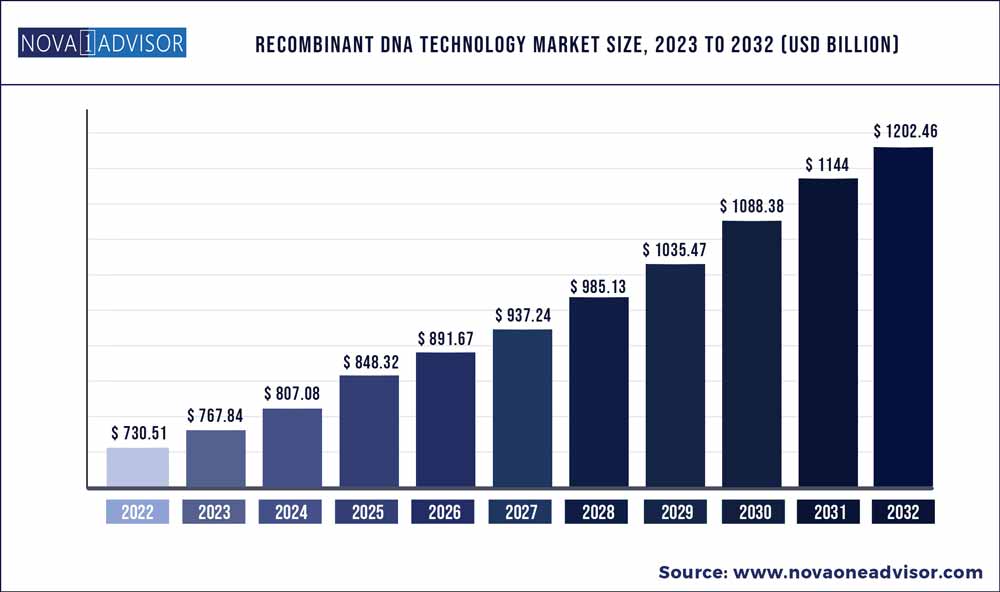The global recombinant DNA technology market size was exhibited at USD 730.51 billion in 2022 and is projected to hit around USD 1202.46 billion by 2032, growing at a CAGR of 5.11% during the forecast period 2023 to 2032.

Key Pointers:
- North America accounted largest revenue share of around 52% in 2022
- In 2022, Europe region garnered market share of around 25%
- Health & disease accounted with the largest share in terms of revenue
Recombinant DNA technology Market Report Scope
| Report Coverage |
Details |
| Market Size in 2023 |
USD 767.84 Billion |
| Market Size by 2032 |
USD 1202.46 Billion |
| Growth Rate from 2023 to 2032 |
CAGR of 5.11% |
| Base Year |
2022 |
| Forecast Period |
2023 to 2032 |
| Segments Covered |
Product, Component, Application, End User, Geography |
| Regions Covered |
North America, Europe, Asia-Pacific, Latin America and Middle East & Africa |
This has extended its usage in widespread applications including conventional as well as non-conventional applications. Over the past years, this space has witnessed tremendous achievement in the production of recombinant drugs and therapeutics without the help of human donors.
The classical example of this achievement is the commercial success of genetically engineered insulin for diabetes treatment. The biotech and pharmaceutical firms are engaged in deciphering the potential of rDNA techniques in various aspects of disease management. This is mainly to combat the soaring burden of chronic diseases and keep pace with the growing therapeutics demand.
Furthermore, the gradual evolution of rDNA techniques has drafted new vistas in taking biopharmaceutical development a step ahead by enabling the construction of a recombinant DNA molecule. The presence of a robust biopharmaceuticals pipeline, in particular, the recombinant proteins pipeline; is expected to drive the adoption of this technology. Development of recombinant products using rDNA techniques accompanied by CRISPR/Cas9 nuclease, ZFN, and TALEN for easy & precise genome editing with no limitation by organisms is largely responsible for the growth of this space. Dozens of review studies carried out by researchers are evident for the efficiency of rDNA technology.
Growth in Genetically Modified (GM) crop hectarage around the world is a testament to the success of this technology in the agriculture and food sector. This has triggered its usage in other non-conventional applications such as the development of biofuel and biopesticides to address environmental issues. However, the use of this technology has been a topic of controversies as a result of attendant ethical considerations in various applications such as gene therapy. In each of the diverse fields of medicine, agriculture, and the environment, scientific and ethical concerns vary in a discipline-specific manner.
Some of the prominent players in the Recombinant DNA technology Market include:
- Pfizer
- Sanofi
- New England Biolabs
- GlaxoSmithKline plc
- GenScript
- Thermo Fisher Scientific, Inc.
- Biogen, Inc.
- Merck & Co., Inc.
- Profacgen
- Amgen, Inc.
- Monsanto Company
Segments Covered in the Report
This report forecasts revenue growth at global, regional, and country levels and provides an analysis of the latest industry trends in each of the sub-segments from 2018 to 2032. For this study, Nova one advisor, Inc. has segmented the global recombinant DNA technology market.
By Product
- Medical
- Therapeutic Agent
- Human Protein
- Vaccines
- Non-Medical
- Biotech Crops
- Specialty Chemicals
- Others
By Component
- Expression System
- Mammalian
- Bacteria
- Yeast
- Baculovirus/Insect
- Cloning Vector
By Application
- Health and disease
- Food and Agriculture
- Environment
- Others
By End User
- Pharmaceutical and biotechnology companies
- Research institutes
- Others
By Region
- North America
- Europe
- Asia-Pacific
- Latin America
- Middle East & Africa (MEA)

